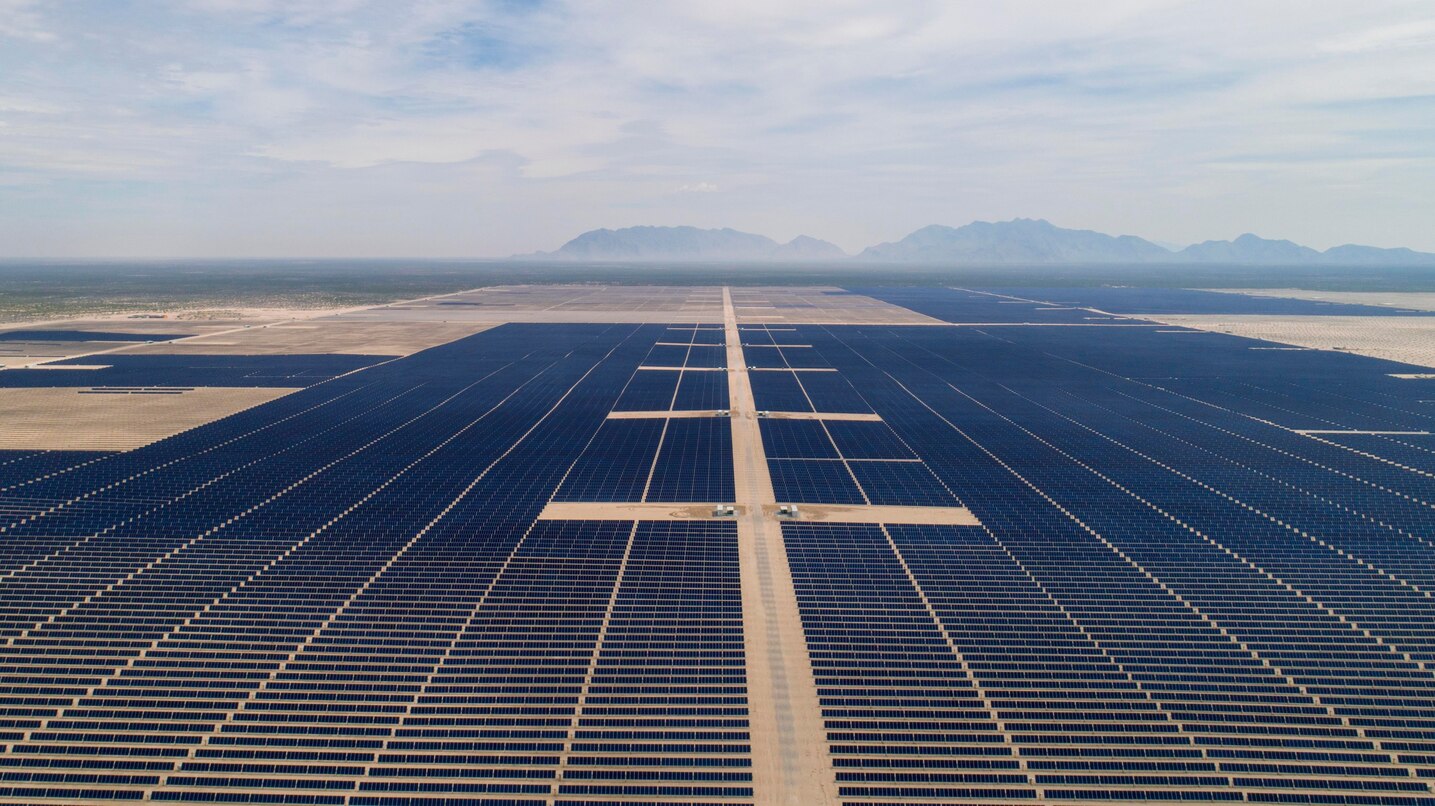- Courses
- GS Full Course 1 Year
- GS Full Course 2 Year
- GS Full Course 3 Year
- GS Full Course Till Selection
- Answer Alpha: Mains 2025 Mentorship
- MEP (Mains Enrichment Programme) Data, Facts
- Essay Target – 150+ Marks
- Online Program
- GS Recorded Course
- Polity
- Geography
- Economy
- Ancient, Medieval and Art & Culture AMAC
- Modern India, Post Independence & World History
- Environment
- Governance
- Science & Technology
- International Relations and Internal Security
- Disaster Management
- Ethics
- NCERT Current Affairs
- Indian Society and Social Issue
- NCERT- Science and Technology
- NCERT - Geography
- NCERT - Ancient History
- NCERT- World History
- NCERT Modern History
- CSAT
- 5 LAYERED ARJUNA Mentorship
- Public Administration Optional
- ABOUT US
- OUR TOPPERS
- TEST SERIES
- FREE STUDY MATERIAL
- VIDEOS
- CONTACT US
PLACES IN NEWS 10th JANUARY 2025
PLACES IN NEWS 10th JANUARY 2025
10-01-2025
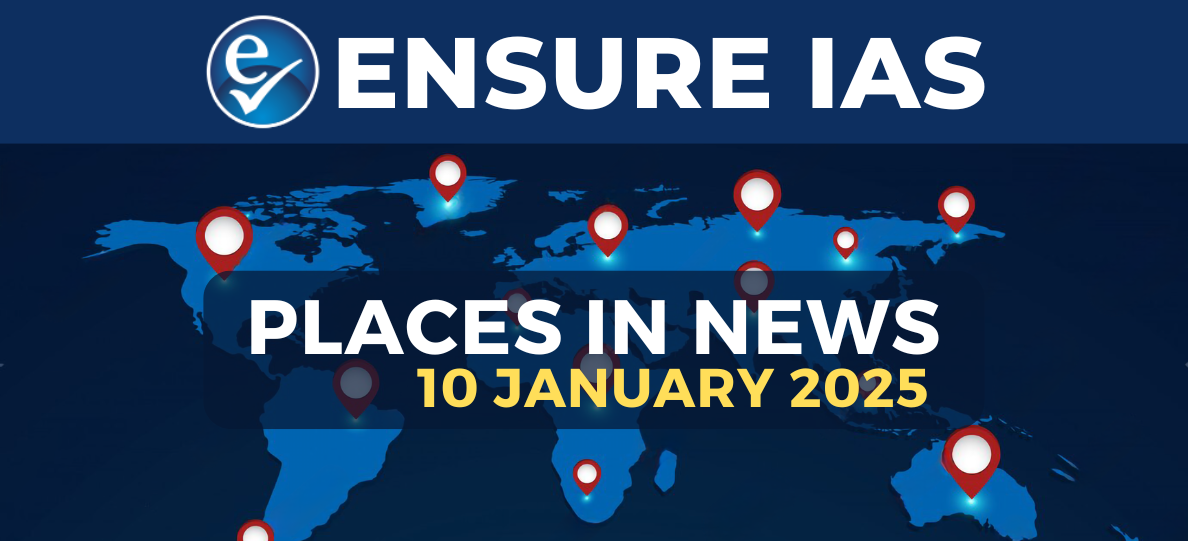
Los Angeles
Why in news?
Los Angeles faced devastating wildfires recently, which consumed thousands of acres of land, destroyed homes, and forced evacuations.
About Los Angeles:
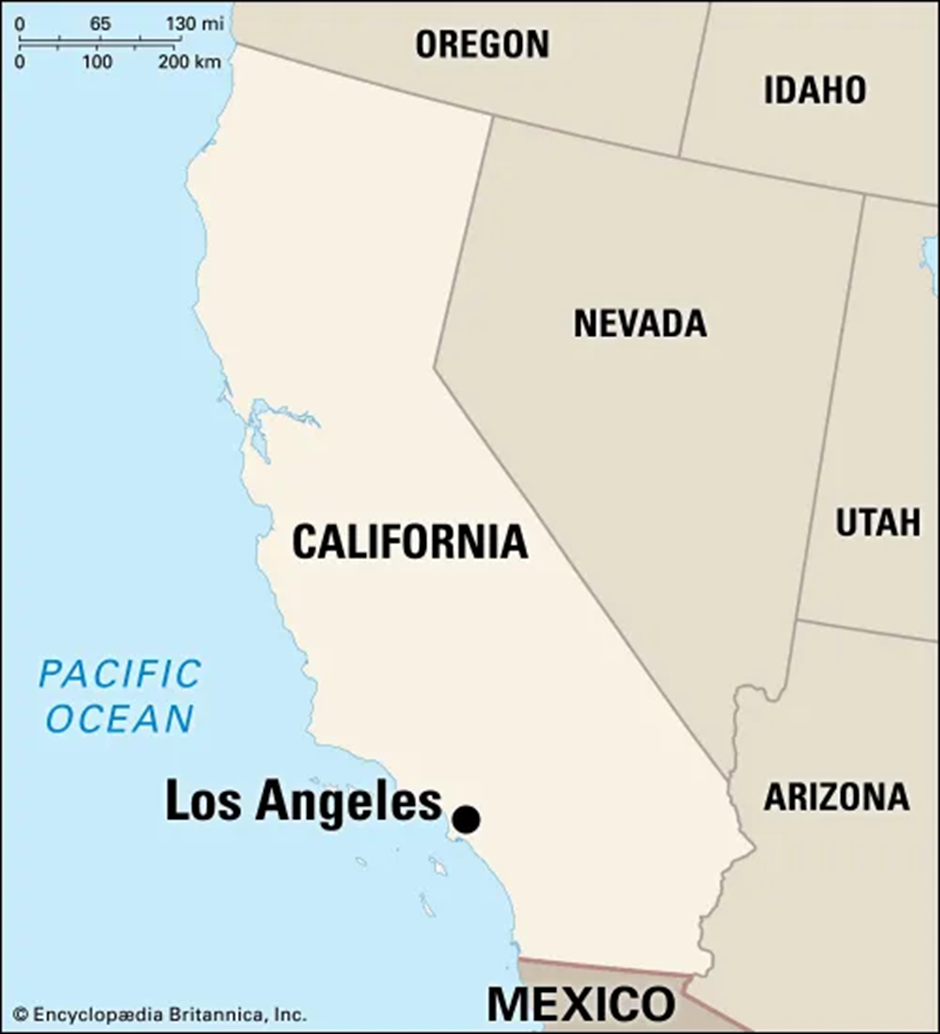
- Los Angeles, in Southern California, is the largest city in the state and the second-most populous city in the United States.
- The city is surrounded by mountains like the San Gabriel and Santa Monica ranges, as well as the Pacific Ocean.
- The terrain includes urban sprawl, canyons, and chaparral ecosystems, which are prone to fire hazards.
- It has a Mediterranean climate, characterised by hot, dry summers and mild, wet winters.
- Natural Vegetation: Chaparral vegetation, consisting of dense shrubs, is common in Los Angeles and highly flammable during dry conditions.
Reasons Behind the Recent Fires
- Prolonged Drought: Persistent drought conditions have left the region with dry vegetation, creating perfect fuel for wildfires.
- Climate Change: Climate change has increased the frequency of heatwaves and reduced precipitation.
- Santa Ana Winds: These strong, dry winds blow through the region during autumn, fanning flames and spreading fires rapidly.
- Human Activities: Unregulated development in wildfire-prone areas and activities like campfires or discarded cigarettes often trigger fires.
- Infrastructure Failures: Power lines and other infrastructure failures occasionally spark fires, especially during windstorms.
Multidimensional Impact of Fires
- Environmental Damage:
- Fires destroyed thousands of acres of forest, disrupting local ecosystems and wildlife habitats.
- They released large amounts of carbon dioxide, worsening climate change.
- Post-fire soil erosion and sedimentation affect water bodies and aquatic life.
- Fires destroyed thousands of acres of forest, disrupting local ecosystems and wildlife habitats.
- Health Hazards:
- The smoke and particulate matter caused severe air quality degradation, leading to respiratory and cardiovascular issues.
- Vulnerable groups, such as children and the elderly, faced higher health risks.
- The smoke and particulate matter caused severe air quality degradation, leading to respiratory and cardiovascular issues.
- Economic Losses:
- Wildfires caused billions in damages, including the destruction of homes, infrastructure, and businesses.
- Insurance claims surged, placing strain on financial systems and property owners.
- Wildfires caused billions in damages, including the destruction of homes, infrastructure, and businesses.
- Social Disruption:
- Thousands of residents were evacuated, facing displacement and emotional trauma.
- Firefighters and emergency responders worked in hazardous conditions, risking their lives.
- Thousands of residents were evacuated, facing displacement and emotional trauma.
- Policy and Awareness:
- The fires spurred discussions on fire management policies, sustainable urban planning, and climate action.
- Increased awareness led to calls for better forest management and renewable energy adoption.
- The fires spurred discussions on fire management policies, sustainable urban planning, and climate action.
Rakhine
Why in news?
In Rakhine, Myanmar, the situation has escalated with intense airstrikes and mounting conflict, particularly involving the Arakan Army (AA).
About Rakhine:
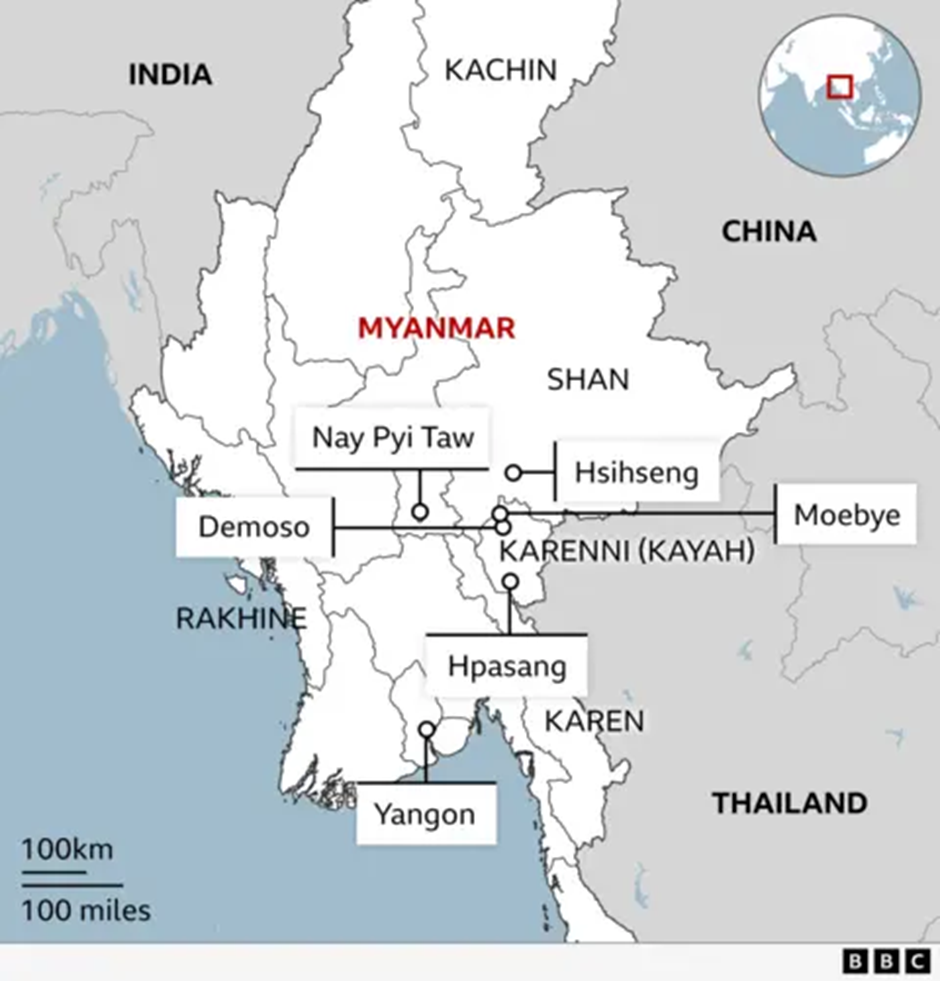
- Rakhine, also known as Arakan, is a coastal state located in the western part of Myanmar.
- The state shares borders with Bangladesh to the northwest and is bounded by the Bay of Bengal to the west. It is a region marked by mountainous terrain, dense forests, and numerous rivers.
- The state is home to diverse ethnic groups, including Rakhine Buddhists, Rohingya Muslims, and other smaller ethnic communities.
Current Civilian Crisis in Rakhine and Other Affected Regions
- Intensified Conflict: The Arakan Army (AA), an ethnic armed group in Rakhine, has been in conflict with Myanmar’s military for several years. The AA is fighting for autonomy for the Rakhine people. This has led to a series of airstrikes, ground assaults, and clashes that have intensified since 2019.
- Humanitarian Impact: The ongoing violence has caused a humanitarian crisis. Thousands of civilians have been displaced from their homes, with Sittwe and other towns witnessing mass exoduses. Displaced persons are often living in overcrowded camps under harsh conditions, facing shortages of food, clean water, and medical supplies.
- Civilian Casualties: Airstrikes and ground offensives have led to a rising number of civilian casualties in Rakhine, especially among the Rohingya community. The violence has also led to widespread suffering, including deaths, injuries, and destruction of property.
- Rohingya Crisis: The Rohingya Muslims in Rakhine have faced systemic persecution and violence for years, including the 2017 exodus where more than 700,000 Rohingya fled to neighbouring Bangladesh due to military-led atrocities. Despite some international attention, the situation for the Rohingya remains dire, with restricted access to basic services.
- Other Affected Regions in Myanmar: The crisis is not limited to Rakhine. Ethnic armed groups in other regions like Kachin, Shan, and Karen states have also been engaged in conflict with the military, resulting in widespread displacement and human rights abuses. The Myanmar military coup in February 2021 further exacerbated tensions, leading to an escalating civil war in multiple parts of the country, with significant civilian suffering in regions such as Chin and Sagaing.
- International Response: International organisations and human rights groups have raised alarms over the violations in Myanmar, urging the military junta to cease hostilities and allow humanitarian access. However, political instability, military control, and limited international intervention have hindered efforts to resolve the crisis.
Chad
Why in news?
- In a recent attack on Chad's presidential palace in N'Djamena, 19 people were killed, and several others were injured.
- The assailants, reportedly from an armed group, launched the assault on the heart of the country's government, causing widespread shock and concern.
- The attack has heightened tensions in Chad, already dealing with political instability and security challenges.
About Chad:
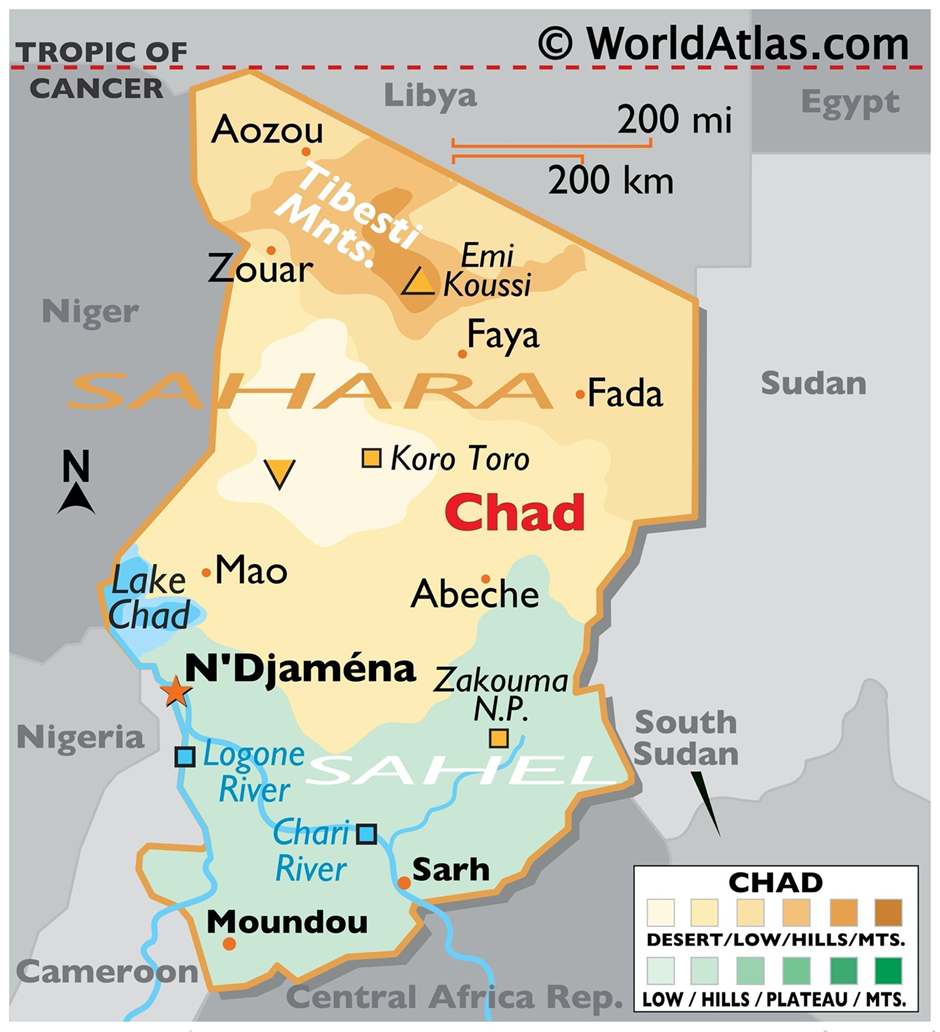
- Geography of Chad:
- Chad is a landlocked country located in North-Central Africa. It is bordered by Libya to the north, Sudan to the east, the Central African Republic to the south, Cameroon and Nigeria to the southwest, and Niger to the west.
- Chad's topography is diverse, ranging from sandy deserts in the north to savannas and tropical forests in the south. The Sahara Desert dominates the northern region, while the central and southern parts are characterised by semi-arid steppe and bushland.
- Chad is home to significant water bodies, with the Chad River being the most prominent, which flows into Lake Chad in the west. Lake Chad, a large and vital lake for the region, has been shrinking due to climate change and over-extraction of water.
- The Tibesti Mountains in the north are the highest point in Chad, with peaks rising to 3,415 meters. The mountains are located in a remote and sparsely populated region, surrounded by desert and rocky terrain.
- Potential Natural Resources
- Chad is one of Africa’s oil-producing nations, with significant oil reserves located in the south of the country. Oil exports are a key contributor to Chad's economy.
- Chad has vast mineral resources, including gold, uranium, and salt. The Tibesti Mountains are rich in minerals, particularly gold, attracting interest from international mining companies.
- Chad has fertile land, especially in the southern region, ideal for growing cotton, maize, sorghum, and millet. Livestock farming, particularly cattle, is also significant in the economy.
- Despite being landlocked, Chad relies on rivers and lakes for water resources, which are crucial for both agriculture and daily life.
- Recent Civilian Crisis in Chad
- Political Instability: Chad has faced ongoing political instability for years, mainly due to the long rule of President Idriss Déby, who governed the country for nearly 30 years until his death in 2021. His sudden death during a military campaign created a power vacuum, leading to political uncertainty and unrest.
- Armed Conflict: The country has been embroiled in internal conflicts, with multiple rebel groups, including the Front for Change and Concord in Chad (FACT), fighting against the government. These groups have cited the oppressive political environment and economic inequality as their primary grievances. Tensions escalated following President Déby’s death, leading to violent clashes, displacement, and widespread suffering.
- Humanitarian Crisis: The fighting between government forces and rebel groups has resulted in a growing humanitarian crisis. Thousands of people have been displaced from their homes, with many seeking refuge in neighbouring countries. The violence has left civilians vulnerable to food insecurity, lack of access to healthcare, and limited protection from violence.
- Regional Impact: Chad’s civilian crisis has spillover effects on neighbouring countries, especially in the Lake Chad Basin, where displaced people cross borders into countries like Niger, Cameroon, and Nigeria. This migration has placed additional strain on the resources and stability of these countries.
- Climate Change: The shrinking of Lake Chad and changing climatic patterns have exacerbated tensions, as resources like water and fertile land become scarcer. The ongoing droughts and desertification, particularly in the north, have worsened the livelihoods of the country’s rural population, leading to competition for resources and conflict over land use.
Afghanistan
Why in news?
- Following a meeting in Dubai, the Taliban stated that Afghanistan poses no threat to India, aiming to reassure India about its security concerns.
- This statement came amidst ongoing diplomatic talks, where India has raised issues regarding terrorism, particularly the Taliban’s ties to the Haqqani network and regional security.
About Afghanistan:
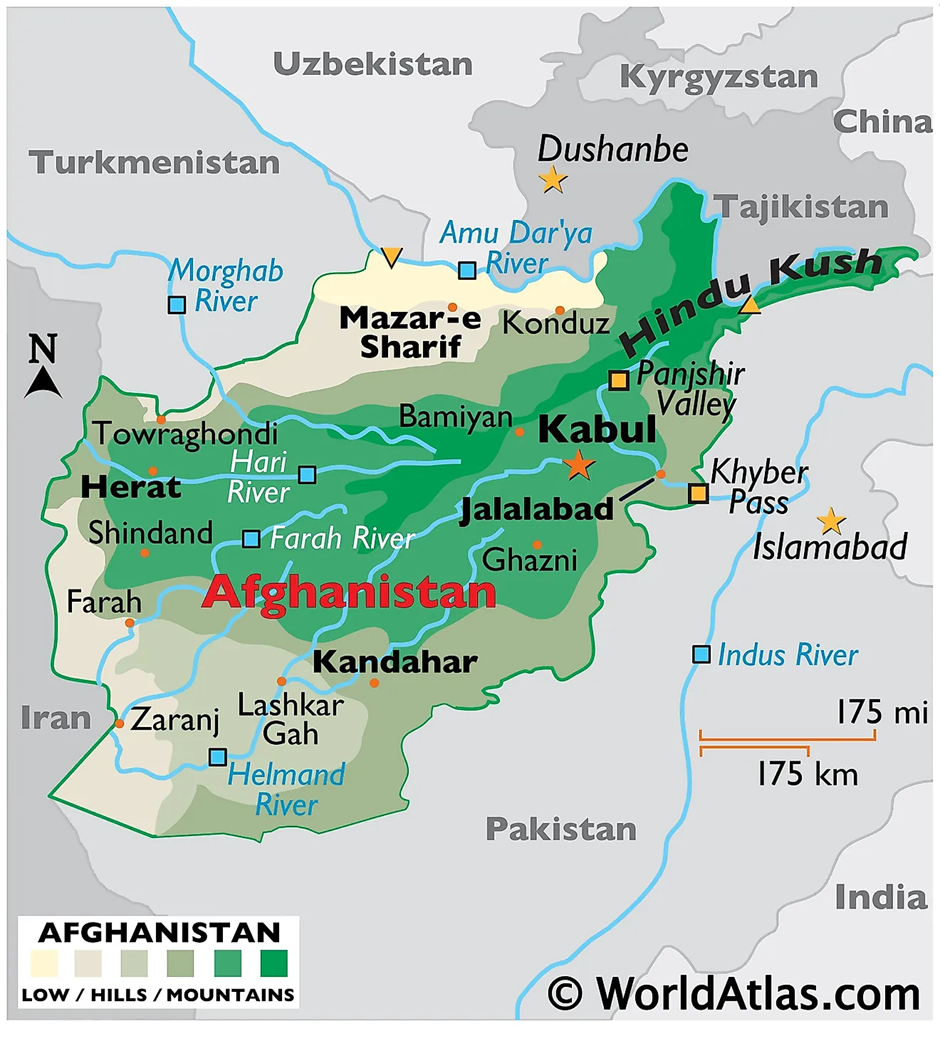
- Afghanistan is a landlocked country located in Central Asia. It is bordered by Pakistan to the south and east, Iran to the west, Turkmenistan, Uzbekistan, and Tajikistan to the north, and China to the far northeast.
- The country is characterised by rugged mountains, particularly the Hindu Kush range that runs through the centre of Afghanistan.
- The terrain also includes desert regions, such as the Registan Desert, and plains in the northern and eastern parts of the country.
- Afghanistan experiences an arid climate, with hot summers and cold winters. The mountainous regions have a more temperate climate, while the lowland areas are prone to extreme heat. Winters can be harsh, with heavy snowfall in the northern parts and droughts occurring in the south.
History of the Taliban:
- Establishment and Early Emergence:
- In 1994, the Taliban, a fundamentalist Islamic group, emerged in the southern regions of Afghanistan in the aftermath of the Soviet withdrawal and the chaotic civil war that followed. The group’s leaders were predominantly Pashtun, hailing from madrassas (Islamic schools) in Pakistan.
- Within two years, the Taliban seized control of Kabul, establishing the Islamic Emirate of Afghanistan and enforcing a strict interpretation of Sharia law. During this period, the Taliban was widely criticised for its human rights violations, particularly against women and ethnic minorities like the Hazaras.
1. Post-9/11 Period: Following the September 11 attacks in the United States, the Taliban's refusal to hand over Osama bin Laden led to a U.S.-led invasion of Afghanistan. The Taliban was ousted from power, but it continued to wage an insurgency against the Afghan government and NATO forces.
2. Resurgence and Return to Power:
- In 2010, the Taliban began to regain strength, particularly in rural areas, as the Afghan government struggled with corruption and weak governance. Despite efforts by the U.S. and NATO to counter the insurgency, the Taliban maintained its grip on large portions of the country.
- In 2020, the U.S.-Taliban peace agreement was signed in Doha, Qatar, which outlined the conditions for a U.S. withdrawal from Afghanistan. This agreement, however, was criticised for excluding the Afghan government and was seen as a signal of the Taliban’s growing influence.
1. Taliban’s Takeover in 2021: As U.S. forces withdrew, the Taliban rapidly advanced across Afghanistan and captured Kabul, leading to the fall of the Afghan government. The Taliban's return to power marked a significant shift in Afghanistan’s political landscape and raised concerns globally regarding the human rights situation and the country’s future under their rule.
Recent Updates on India-Taliban Talks:
- Humanitarian Aid: India has provided humanitarian aid to Afghanistan, including the delivery of medical supplies, food assistance, and COVID-19 vaccines, in collaboration with international organisations.
- Diplomatic Channels: While India has not formally recognised the Taliban government, it has opened diplomatic channels for dialogue, mainly focusing on humanitarian and security concerns. India has also emphasised the need for the protection of Afghan minorities and women's rights under the new regime.
- Engagement with Regional Partners: India is working closely with regional partners, including Russia and Iran, to address the security and political challenges arising from the Taliban's return to power while maintaining its strategic interests in the region.
|
UPSC CSE PYQs Q1. Consider the following countries:
Which of the above have borders with Afghanistan? (2022)
Answer: Option C Q- Consider the following pairs:
Which of the pairs given above are correctly matched? (2018)
Answer: Option B Q: Consider the following pairs:
Which of the pairs given above is/are correctly matched? (2016)
Answer: Option C
|
|
Also Read |
|
UPSC Foundation Course |
|
| CSAT Foundation Course | |

